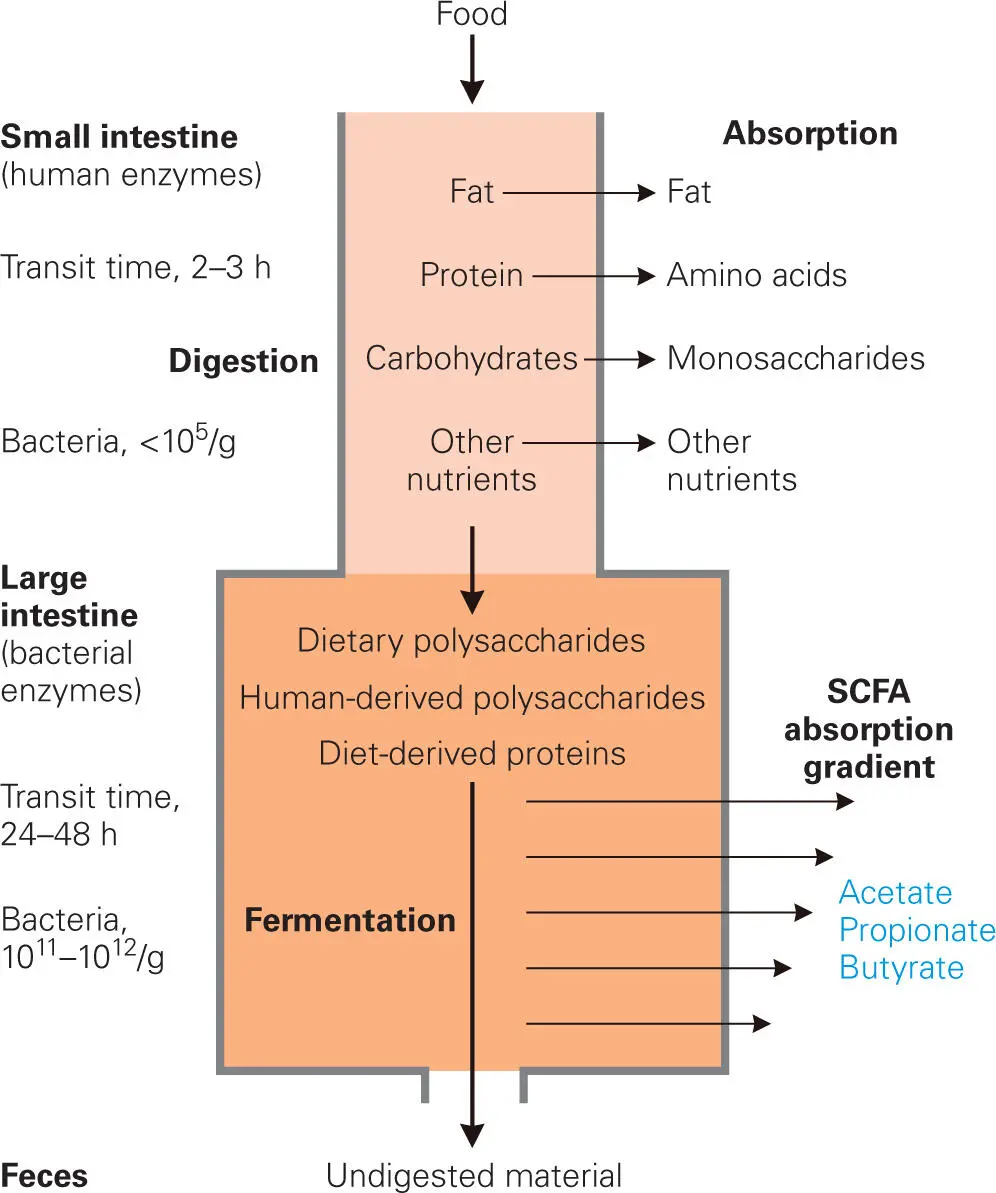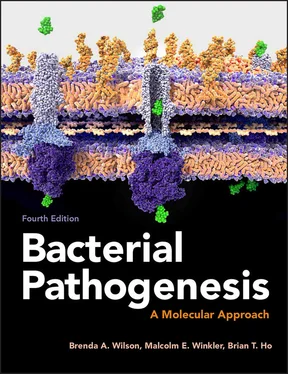Skin Microbiota
The surface of the skin is a dry, slightly acidic, and aerobic environment. Early culture-based studies determined that Gram-positive staphylococci, such as Staphylococcus epidermidis, are the predominant bacteria occupying this site, although it is not uncommon to have transient colonization of the skin by soil bacteria or bacteria from other parts of the body. Skin bacteria like S. epidermidis were long assumed to be unable to cause disease. Finding them in a blood specimen, for example, was considered to be proof that it was introduced via a careless health care worker or a technician that had contaminated the specimen. Although the surface of the skin is aerobic, pores and hair follicles can be anoxic enough to support the growth of anaerobic bacteria, such as Propionibacterium acnes (see chapter 2). Today’s view of the skin microbiota is completely different. Comparison of 16S rRNA gene-based community profiles from skin at different locations showed not only high variability from person to person (interpersonal variation), but also high variability within an individual (intrapersonal variation) ( Figure 5-16). While Propionibacteriaceae dominate the microbiomes of head regions (60–80%) and arms (20–40%), the torso and legs are dominated by Staphylococcus and Corynebacterium species. Skin sites also vary considerably in the bacterial diversity of minor bacterial species present. Indeed, it has been proposed that skin bacterial community profiles could serve as a valuable aid in forensic identification.
Oropharyngeal Microbiota
The most common source of S. aureus, a major cause of hospital-acquired and community-acquired infections, is the human nose, where it is most abundant in the upper part of the nasal cavity. At any particular time, about one-third of the human population harbors S. aureus. The nasopharynx is also home to S. pneumoniae, another human commensal bacterium that can cause a variety of serious invasive diseases elsewhere in the body. About 25% and 40% of healthy adults and children, respectively, carry S. pneumoniae at any given time. Lower in the nose, not surprisingly, are bacteria that are also found on the skin. Several large-scale efforts are currently underway to understand the composition of the microbiota and the dynamics of colonization of the nose.
The microbiota of the mouth and throat is fairly well characterized, largely due to the involvement of the oral microbiota in periodontal disease, a major cause of gum disease and tooth loss in adults. The microbiota of the healthy mouth consists largely of facultative Gram-positive bacteria, mainly streptococci such as Streptococcus mutans and Streptococcus salivarius, which are not completely innocuous. These bacteria ferment sucrose to lactic acid, which in turn contributes to the development of dental caries. Utilization of sucrose also results in production of the polysaccharide dextran, which binds bacteria together and allows plaque to form. In periodontal disease, this Gram-positive microbiota shifts to a Gram-negative anaerobic microbiota in the area of the gums. The space between the gums and the upper portion of the tooth surface is called the periodontal pocket. It is a fairly anoxic area and so is able to support the growth of obligate anaerobes, such as Porphyromonas gingivalis, Prevotella spp, Tannerella forsythia, and Treponema denticola. These species produce proteases and other tissue-degrading enzymes, and this may be a major cause of the inflammation that characterizes the disease. As we will discuss at length in chapter 6, P. gingivalis appears to act as a “keystone” or “trigger” pathogen by altering the normally benign composition of the commensal microbiota, leading to microbial dysbiosis and increased inflammation and periodontal disease.
More recently, scientists have found that bacteria involved in periodontal disease, such as the Gram-negative anaerobe Fusobacterium nucleatum, are responsible for some cases of preterm birth. The hypothesis is that the bacteria enter the bloodstream through the inflamed gum tissue and lodge in the placenta. The resulting inflammation causes the fetus to be delivered prematurely. Similarly, others have suggested that oral bacteria associated with gingivitis might enter the bloodstream, causing inflammation in the blood vessels and thus leading to heart disease. In fact, it is now established that some oral bacteria, such as Streptococcus sanguinis and Streptococcus pyogenes, are direct causes of endocarditis. These examples illustrate the new thinking about connections between alterations in the normal microbiota and the impact on diseases in other areas of the body. More examples can be found in the suggested readings at the end of this chapter.
Microbiota of the Small Intestine and Colon
The small intestine is characterized by the fast flow of contents (see chapter 2). The fast flow helps wash bacteria out of the site. Throughout most of the small intestine, fast flow of contents prevents bacteria from adhering to the mucosa in order to stay in the site. The human microbiota of the small intestine is poorly characterized, largely because it is difficult to obtain samples from that area. Samples are usually obtained through a swallowed tube that works its way into the small intestine. Although such tubes have been used, from a microbiological perspective they have a significant deficiency; namely, they sample the lumenal but not the adherent microbiota. In mice, where such studies have been feasible, there is an adherent microbiota of the small intestine that consists mostly of Clostridium species.
The lower intestine or colon, by contrast, has a much slower flow of contents (see chapter 2) and much higher concentrations of adhering and colonizing bacteria ( Figure 5-17). Bacteria make up a third of the microbial content of the human colon. These microbes have a complex relationship with us. We provide them with ingested food and fermentable substances like mucins, while the bacteria further degrade complex, undigested foodstuffs into substances that contribute to our nutrition. The human small intestine can absorb small molecules such as mono- and disaccharides, and can digest soluble starch, but most of the complex polysaccharides in the human diet, such as cellulose, xylan, and less soluble starch, pass through to the colon. Colonic bacteria ferment carbohydrates, including these polysaccharides, to produce CO2, H2, and short-chain fatty acids (SCFAs; acetate, propionate, and butyrate), which are absorbed by intestinal cells and used as a source of carbon and energy, providing as much as 8–10% of human nutrition. Colonic bacteria also ferment host-produced polysaccharides, such as mucopolysaccharides and mucins.

Figure 5-17. A schematic view of activities of the colonic microbiota. In the small intestine, concentrations of bacteria are low due to the fast flow of contents and human intestinal enzymes that mediate most of the digestion. In the colon, concentrations of bacteria are so high that bacteria account for about 30% of the volume or contents. In this site, the colonic bacteria ferment polysaccharides from the human diet (plant polysaccharides or dietary fiber), host-derived polysaccharides (mucins and mucopolysaccharides), and diet-derived proteins (those not digested by pancreatic enzymes in the small intestine). The resulting short-chain fatty acids (SCFAs; 85–95% of SCFAs produced in the colon are acetic acid, propionic acid, and butyric acid) and amino acids are absorbed by the human body and used as sources of carbon and energy.
Colonic bacteria not only break down food material into simple sugars, amino acids, and lipids (catabolism), but also synthesize other nutrients and vitamins (anabolism) that our bodies need. Indeed, emerging experimental evidence points to a number of important functional roles that microbiota play in providing metabolites and host-microbe interactions that stimulate multiple endocrine, neurocrine, and immunologic signals to the brain and vice versa. These bidirectional interactions have been dubbed the microbiota-gut-brain axis. Recent studies have shown that modulating the gut microbiota impacts emotional behavior, including anxiety, depression, and pain, supporting the therapeutic potential of appropriate probiotics, prebiotics, and diet as interventions for psychiatric and neuroimmune disorders.
Читать дальше













